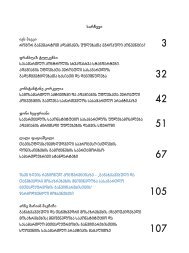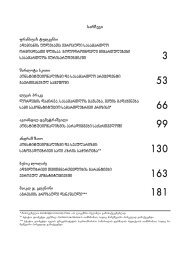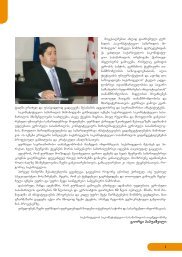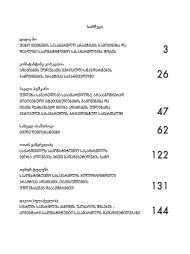Contents - Constitutional Court of Georgia
Contents - Constitutional Court of Georgia
Contents - Constitutional Court of Georgia
Create successful ePaper yourself
Turn your PDF publications into a flip-book with our unique Google optimized e-Paper software.
The European <strong>Court</strong><strong>of</strong> Human Rights is Fifty. Recent trends in the <strong>Court</strong>’s jurisprudence<br />
So, today, conflicts <strong>of</strong> rights require original methods <strong>of</strong> resolution – but the structures<br />
for these are still to be built. We could go along the lines suggested by the German constitutional<br />
lawyer K. Hesse, <strong>of</strong> the “practical compromise” (“concordance pratique”) 25 which<br />
appear in a number <strong>of</strong> decisions <strong>of</strong> the Bundesverfassungsgericht. When we are confronted<br />
with conflicting rights, it is not appropriate to turn immediately to the scales in order to determine<br />
which right is the “most weighty” and deserves to be sacrificed to the other rights.<br />
It seems better to see if some compromises, from both sides, could be reached in order<br />
to avoid sacrifice on either side. The originality <strong>of</strong> this approach is to encourage solutions<br />
which preserve, as far as possible, the two conflicting rights instead <strong>of</strong> trying to find a point<br />
<strong>of</strong> balance between them 26 .<br />
That is the meaning <strong>of</strong> the Öllinger v. Austria judgment <strong>of</strong> 29 June 2006. On 30 October<br />
1998 the applicant notified the Salzburg Federal Police Authority that, on All Saints’ Day (1<br />
November) 1998 from 9 a.m. until 1 p.m., he would be holding a meeting at the Salzburg<br />
municipal cemetery in front <strong>of</strong> the war memorial in commemoration <strong>of</strong> the Salzburg Jews<br />
killed by the SS during the Second World War. He noted that the meeting would coincide<br />
with the gathering <strong>of</strong> Comradeship IV (Kameradschaft IV), in memory <strong>of</strong> the SS soldiers<br />
killed in the Second World War. On 31 October 1998 the Salzburg Federal Police Authority<br />
prohibited the meeting and, on 17 August 1999, the Salzburg Public Security Authority<br />
dismissed an appeal against that decision by the applicant. The police authority and public<br />
security authority considered the prohibition <strong>of</strong> the applicant’s assembly necessary in order<br />
to prevent disturbances <strong>of</strong> the Comradeship IV commemoration meeting, which was<br />
considered a popular ceremony not requiring authorisation. “In [the] circumstances [<strong>of</strong> the<br />
case], the <strong>Court</strong> is not convinced by the Government’s argument that allowing both meetings<br />
while taking preventive measures, such as ensuring police presence in order to keep<br />
the two assemblies apart, was not a viable alternative which would have preserved the applicant’s<br />
right to freedom <strong>of</strong> assembly while at the same time <strong>of</strong>fering a sufficient degree <strong>of</strong><br />
protection as regards the rights <strong>of</strong> the cemetery’s visitors” 27 .<br />
B. As far as the substantive provisions <strong>of</strong> the Convention are concerned – the rights and<br />
freedoms themselves as they are enshrined in Part I <strong>of</strong> the Convention, Articles 2 to 18 – I will<br />
very briefly highlight the most significant developments for some articles 28 while showing how we<br />
are confronted with a number <strong>of</strong> new issues.<br />
25 K. Hesse, Grundzüge des Verfassungsrechts der Bundesrepublik Deutschland, Heidelberg, C.F. Müller, 1984, 14th ed., nos. 71 et seq. On<br />
this “practical concordance”, see also, F. Müller, Discours de la méthode juridique, transl. from German by O. Jouanjan, Paris, PUF, 1996,<br />
pp. 285-287, and S. Van Drooghenbroeck, La proportionnalité dans le droit de la Convention européenne des droits de l’homme. Prendre<br />
l’idée simple au sérieux, Brussels, Publications des Facultés Universitaires Saint-Louis / Bruylant, 2001, p. 212 and pp. 709-710.<br />
26 See O. De Schutter and Fr. Tulkens, “Rights in Conflict: the European <strong>Court</strong> <strong>of</strong> Human Rights as a Pragmatic Institution”, in E. Brems (ed.),<br />
Conflicts between Fundamental Rights, Antwerp, Intersentia, 2008, pp. 169-216.<br />
27 ECtHR, Öllinger v. Austria, judgment <strong>of</strong> 29 June 2006, § 48.<br />
28 For a general overview, see K. Reid, A Practitioner’s Guide to the European Convention on Human Rights, London, Sweet & Maxwell,<br />
3rd edition, 2008.<br />
11






